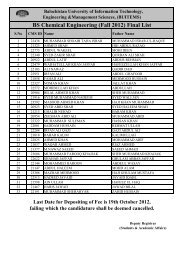BUITEMS
Research Journal - buitems
Research Journal - buitems
- No tags were found...
You also want an ePaper? Increase the reach of your titles
YUMPU automatically turns print PDFs into web optimized ePapers that Google loves.
<strong>BUITEMS</strong><br />
Quality & Excellence in Education<br />
Orange peel as an adsorbent for the removal of reactive blue dye from textile wastewater.<br />
Shaking time<br />
The different amounts of shaking time were<br />
used to obtain the maximum removal of color<br />
from the aqueous solution, the shaking time<br />
for 15, 25, 35, 45 and 55 minutes were used.<br />
The dye removal of 76-92% was obtained<br />
with maximum contact time of 55 minutes and<br />
was used for further experimental trials.<br />
Shaking Speed<br />
The different shaking speed were used to<br />
obtain the maximum removal of color from<br />
the aqueous solution, The shaking speed of<br />
80, 100, 120, 140 and 160 rpm were used. It<br />
was found that on the maximum shaking<br />
speed of 55 rpm, the maximum dye removal<br />
of 84-89% was obtained and used for further<br />
experimental trials.<br />
The tests were performed in triplicate on lab<br />
scale for the removal of color from aqueous<br />
solution of reactive blue dye with different dye<br />
concentrations on orange peel. The solution<br />
was prepared by putting different doses 25,<br />
50, 75, 100, and 125 mg/L of dye into 1000<br />
ml of distilled water. Different experimental<br />
parameters were optimized first and used to<br />
get the best results of adsorption for reactive<br />
blue dye on orange peel. The adsorbent dose<br />
of (50 mg/L), size of 600 and 1200 um,<br />
shaking time (55 minutes), pH (8.0-9.0),<br />
shaking speed (160 rpm) were found to be<br />
satisfactory where the adsorption was<br />
maximum. The dye solution with pH of 8.0<br />
and 9.0 was poured in to glass flasks.<br />
Different particle size and doses of orange<br />
peel were used and shaken in with oscillating<br />
dyeing machine at different rpm and shaking<br />
time; then the samples were taken for color<br />
removal analysis.<br />
The solution was filtered with Whatman filter<br />
paper to separate the solution and peels. The<br />
UV-Light Spectrophotometer (Biochrom-<br />
Libra S22) was used to analyze the color<br />
removal percentage. The five serum flasks<br />
four of them were filled with dye solution after<br />
adsorption process and one with initial dye<br />
concentration. The obtained results were<br />
compared and calculated by Bear-Lambert<br />
law; the obtained values were plotted on<br />
linear graphs to show the isotherms analysis.<br />
The Langumir and Freundlich isotherms were<br />
used to show the color removal percentage<br />
of reactive blue dye on different parameters.<br />
RESULTS AND DISCUSSION<br />
Effect of pH and Dye Concentration<br />
Table: 2 Shows the effect of pH and dye<br />
concentration on dye removal<br />
The effect of pH on the adsorption<br />
percentage of dye by orange peels was<br />
examined over a range of pH values from 2.0<br />
–12.0, as the results showed that the amount<br />
of adsorption decreases when the pH is<br />
decreased to 2.0-4.0, as shown in in Graph.1.<br />
With initial dye concentration of 25mg/L<br />
adsorption was maximum and decreased<br />
when the dye concentration was increased<br />
to 100 and 125mg/L. The dye removal was<br />
maximum at pH of 8.0 to 9.0 and decreased<br />
as the pH increased to alkaline pH of 9.0-12.0<br />
at initial concentration of 25 mg/L.<br />
Figure: 1 shows the percentage of dye removal at<br />
different concentrations<br />
On observing the effect of dye concentration,<br />
it was found that the maximum dye<br />
concentration gave slow adsorption on<br />
orange peel. Because after a definite time the<br />
dye concentration came to equilibrium level,<br />
where further adsorption was minimum or<br />
zero. The results showed that maximum<br />
50
















